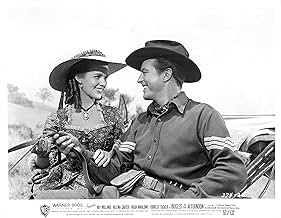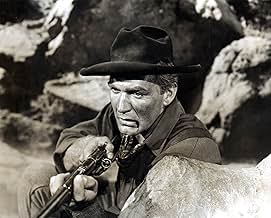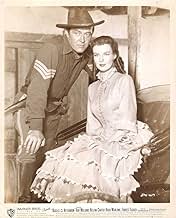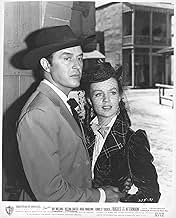After violently attacking a fellow officer Lt. Edward Garnett, cavalry Captain Kern Shafter is court martialled. Later, he rejoins the army with Custer's regiment at Fort Lincoln, Dakota, be... Read allAfter violently attacking a fellow officer Lt. Edward Garnett, cavalry Captain Kern Shafter is court martialled. Later, he rejoins the army with Custer's regiment at Fort Lincoln, Dakota, becoming a sergeant, where he runs into his old foe.After violently attacking a fellow officer Lt. Edward Garnett, cavalry Captain Kern Shafter is court martialled. Later, he rejoins the army with Custer's regiment at Fort Lincoln, Dakota, becoming a sergeant, where he runs into his old foe.
Mary Adams
- Woman
- (uncredited)
Carl Andre
- Trooper
- (uncredited)
Brandon Beach
- Telegrapher
- (uncredited)
Hugh Beaumont
- Lt. Cooke
- (uncredited)
Ray Bennett
- Minor Role
- (uncredited)
Rudy Bowman
- Trooper
- (uncredited)
Virginia Brissac
- Mrs. Carson
- (uncredited)
Bill Coontz
- Trooper
- (uncredited)
- Director
- Writers
- All cast & crew
- Production, box office & more at IMDbPro
Storyline
Did you know
- TriviaWhen Ray Milland's character views the aftermath of Custer's battle at the Little Big Horn through binoculars, footage from They Died with Their Boots On (1941)--also a Warner Bros. film--is used.
- GoofsObvious stunt doubles used in the fight between Shafter and Donavan and in the two fights between Shafter and Garnett.
- ConnectionsEdited from They Died with Their Boots On (1941)
Featured review
BUGLES IN THE AFTERNOON (1952) uses the stirring saga of Custer's Last Stand as a backdrop for a rather trite story of a love triangle involving two cavalry officers in love with the same woman. Ray Milland plays Kern Shafter, an army Colonel who was stripped of his rank and dishonorably discharged for stabbing another officer, Captain Edward Garnett (Hugh Marlowe), with a saber during the Civil War. Ten years later, Shafter finds himself on a cavalry outpost in the Dakota Territory, under the command of the very same officer. Soon, they come to blows over a new woman, Josephine Russell, played by Helena Carter. Garnett assigns Shafter to increasingly dangerous missions, culminating in the scouting of Indian positions just before the action at Little Big Horn.
There is lots of action, great location photography and numerous enjoyable western scenes of men on horseback fighting Indians and rescuing townsmen and such. Unfortunately the film is badly miscast. Ray Milland is too laidback for a role that required someone a bit younger, tougher and more embittered, like John Payne (who excelled in this kind of role in films like CAPTAIN CHINA, CROSSWINDS and PASSAGE WEST) or a bit more ramrod straight like Randolph Scott, who was making plenty of westerns for the same studio (Warner Bros.) at the time. While she's absolutely gorgeous, Helena Carter has such polished diction and precise finishing school manners that she never appears believable as a settler in this hardscrabble western territory. She never shows emotion and scolds her two would-be lovers with carefully measured words rather than letting loose a little honest fury at them for their ridiculous behavior. Hugh Marlowe excelled at playing smarmy, officious types, but he wasn't much of a tough guy and never poses a sufficiently convincing threat to the hero. Worse, there are three great actors in the supporting cast who excelled at playing heavies-Forrest Tucker, Barton MacLane, and James Millican-yet they all play nice guys here. What a waste! Tucker, in particular, seems to be auditioning for a part in a John Ford western by imitating both Ward Bond and Victor McLaglen.
Luckily, the Sioux and Cheyenne are on hand to menace the cavalry. In one of the best scenes, early in the film, Milland rides alone into a band of armed, hostile Sioux to identify and apprehend two braves wanted for murdering a trio of prospectors. Marlowe hopes the Sioux will kill him, but Milland gets his suspects and rides out unharmed. The Sioux are led by Chief Red Owl, played by Indian actor John War Eagle. The other Sioux are all played by real Indians as well. Later in the film, Sheb Wooley is seen briefly as Custer. George (Superman) Reeves has a small part as one of the cavalry officers. The film was produced by William Cagney (James's brother), directed by Roy Rowland, and written by veteran screenwriters Geoffrey Homes and Harry Brown from a novel by famed western author Ernest Haycox.
There is lots of action, great location photography and numerous enjoyable western scenes of men on horseback fighting Indians and rescuing townsmen and such. Unfortunately the film is badly miscast. Ray Milland is too laidback for a role that required someone a bit younger, tougher and more embittered, like John Payne (who excelled in this kind of role in films like CAPTAIN CHINA, CROSSWINDS and PASSAGE WEST) or a bit more ramrod straight like Randolph Scott, who was making plenty of westerns for the same studio (Warner Bros.) at the time. While she's absolutely gorgeous, Helena Carter has such polished diction and precise finishing school manners that she never appears believable as a settler in this hardscrabble western territory. She never shows emotion and scolds her two would-be lovers with carefully measured words rather than letting loose a little honest fury at them for their ridiculous behavior. Hugh Marlowe excelled at playing smarmy, officious types, but he wasn't much of a tough guy and never poses a sufficiently convincing threat to the hero. Worse, there are three great actors in the supporting cast who excelled at playing heavies-Forrest Tucker, Barton MacLane, and James Millican-yet they all play nice guys here. What a waste! Tucker, in particular, seems to be auditioning for a part in a John Ford western by imitating both Ward Bond and Victor McLaglen.
Luckily, the Sioux and Cheyenne are on hand to menace the cavalry. In one of the best scenes, early in the film, Milland rides alone into a band of armed, hostile Sioux to identify and apprehend two braves wanted for murdering a trio of prospectors. Marlowe hopes the Sioux will kill him, but Milland gets his suspects and rides out unharmed. The Sioux are led by Chief Red Owl, played by Indian actor John War Eagle. The other Sioux are all played by real Indians as well. Later in the film, Sheb Wooley is seen briefly as Custer. George (Superman) Reeves has a small part as one of the cavalry officers. The film was produced by William Cagney (James's brother), directed by Roy Rowland, and written by veteran screenwriters Geoffrey Homes and Harry Brown from a novel by famed western author Ernest Haycox.
- BrianDanaCamp
- Jan 18, 2002
- Permalink
- How long is Bugles in the Afternoon?Powered by Alexa
Details
- Runtime1 hour 25 minutes
- Aspect ratio
- 1.37 : 1
Contribute to this page
Suggest an edit or add missing content

Top Gap
By what name was Bugles in the Afternoon (1952) officially released in India in English?
Answer



































